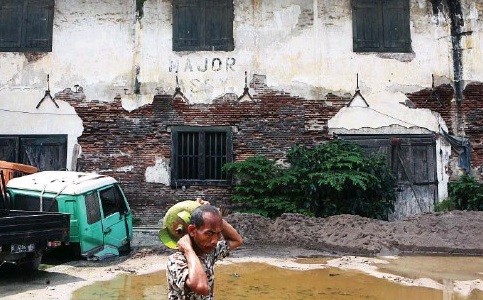Batavia warehouse ‘will probably collapse’
People who pass by barely notice the colonial Graanpakhuizen (grain warehouse) building struggling to remain erect beside piles of gravel, sand, infrastructure equipment and general debris at the military office and dormitory complex on Jl. Tongkol in Pademangan, North Jakarta.
Change Size
 A man walks past a dilapidated colonial era warehouse building in the Kampung Tongkol area, North Jakarta. The warehouse, built during the Dutch colonial era, is likely to collapse soon. (JP/AWO)
A man walks past a dilapidated colonial era warehouse building in the Kampung Tongkol area, North Jakarta. The warehouse, built during the Dutch colonial era, is likely to collapse soon. (JP/AWO)
P
eople who pass by barely notice the colonial Graanpakhuizen (grain warehouse) building struggling to remain erect beside piles of gravel, sand, infrastructure equipment and general debris at the military office and dormitory complex on Jl. Tongkol in Pademangan, North Jakarta.
Constructed in the 1600s, it is one of the oldest buildings left in Jakarta and yet, residents at a nearby food stall shook their heads when asked whether they knew the historical significance of the building.
The two-story grain warehouse has been left to deteriorate to an alarmingly fragile state. As its walls continue to crumble, wild plants grow through the ceiling and pierce its roof. And yet, with its large wooden window and massive teak beams holding strong, somehow the original elegance of the building remains.
Archeologist Candrian Attahiyat voiced his concern, emphasizing that the condition of the building was worrying. “If there is no preservation effort, the building will probably collapse in one and a half years,” he predicted.
Candrian said the city administration had not done anything to preserve the building, nor had it attempted to protect the building from activities that may worsen its condition. Part of the problem, according to Candrian, is that the building is located on Army property. “The administration discussed taking responsibility for the building several times but an agreement was never reached,” he said.
Candrian said the city administration was unable to allocate funds for the building if it was owned by another party.
The building was empty and the door was locked when The Jakarta Post visited the premises, but it appeared as if people had been living inside as cupboards and other equipment was visibly stored there. The settlers had even paved the floor and built a basin inside.
The archeologist said that the remaining building represents merely one-third of the original grain warehouse, two rows of long buildings. “The other parts were torn down in 1995 when the city built the elevated toll road. Another part was dismantled to expand the parking space for trucks,” he said.
Candrian said the building was built after 1650, following the construction of the Batavia (Jakarta) wall. “The building was used as a grain warehouse by the Dutch East India Company [VOC],” he said.
The building was not torn down by Marshal Daendels when he moved Batavia south of Kota Tua in 1809. “As the building was still functional. It was not torn down,” Candrian said, adding that, visitors were still able to see the remaining defensive wall and bastion — most of which was torn down by Daendel — as the wall of Batavia had become the wall of the building. Candrian explained that after it was taken over by the military, the building had been rented to several private entities for storage and had been used as an office until last year. “It is too dangerous to live in the building now. It may collapse at any time,” he said.
Candrian urged the city administration to take over the building and preserve it before it was too late.
Indonesian Architecture Documentation Center (PDAI) executive director Febriyanti Suryaningsih whose team surveyed the building, expressed her concern over the negligence of the building.
“We are afraid that the cement will prevent water from being dissolved by the earth, so the building will be inundated,” she said.
Behind the building, Febriyanti said, was the abandoned Dutch Colonial wall. “If we look, it is possible to see traces of the wall, for example, the path soldiers passed while watching the port,” she said.
She said she hoped the city administration could conduct research to determine the best way to preserve the heritage of the building.
Muhammad Gugun, a resident who lives behind the building said that the cement mixing activities had started in 2012. “The cement mixing site was previously located not far from here but then it moved to the building,” he said.
Gugun said the building was once used as the office of the company that produced the cement. “A number of officials came and asked them to vacant the building,” he said, adding that he, however, had not seen any attempt made to save the building.









